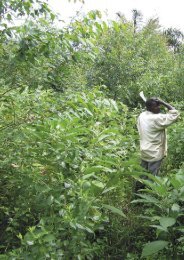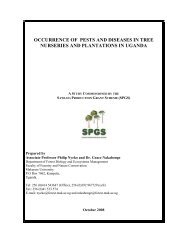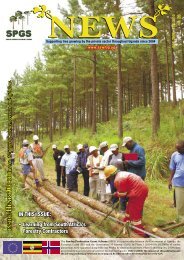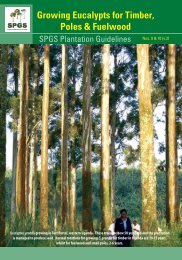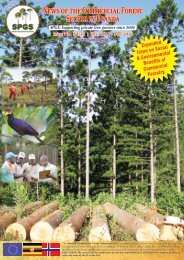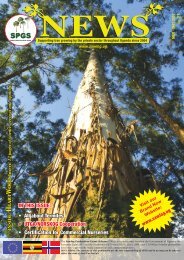Create successful ePaper yourself
Turn your PDF publications into a flip-book with our unique Google optimized e-Paper software.
SAWLOG PRODUCTION GRANT SCHEME - SEPT - NOV. 2010. ISSUE NO. 29<br />
OPPORTUNITY KNOCKS<br />
by Paul Jacovelli, <strong>SPGS</strong> Chief Technical Advisor<br />
Almost as we went to press,<br />
a cutting arrived on my<br />
desk from the East African<br />
newspaper (August 16-<br />
22, 2010) that caused<br />
me to hastily re-write my article. It was<br />
head-lined “TIMBER-STARVED KENYA<br />
SEEKS NEW SUPPLIES” and explained<br />
how a chronic timber shortage has hit<br />
Kenya forcing the country to import<br />
from DRC and Angola. It seems that<br />
since a logging ban imposed in Forest<br />
Reserves by government in 2000, Kenya<br />
has relied on private growers’ trees and<br />
Tanzanian plantations for construction<br />
timber but all these supplies are now<br />
drying up. The Kenya Forests Working<br />
Group National Coordinator, Rudolph<br />
Makhanu says that “worse is the fact that<br />
there is no incentive for farmers engaged<br />
in tree farming”. Not a good time to die<br />
either it seems because the huge rise in<br />
timber prices means that coffins which<br />
used to sell for around US$190 are now<br />
$750.<br />
If you are a commercial tree grower<br />
in Uganda reading this I am sure you<br />
are smiling. Of course, our timber<br />
plantations are still young, with many<br />
having only started planting in earnest<br />
around 2004. Nevertheless, those trees<br />
are coming up to 7 years old and some<br />
are starting to look like sawlogs! Maybe<br />
Kenya needs to look more seriously<br />
at the <strong>SPGS</strong> model, which is certainly<br />
achieving results and attracting<br />
hundreds of entrepreneurs into tree<br />
growing as a business. We know that<br />
Tanzania is investigating the possibility,<br />
with the Finnish government currently<br />
funding a feasibility study there. For<br />
those who would like to read about the<br />
<strong>SPGS</strong> model in a nut-shell, access the<br />
paper <strong>SPGS</strong> presented at the Edinburgh<br />
Conference at www.sawlog.ug<br />
Whilst Uganda is showing the way in<br />
terms of plantation establishment in<br />
the region, we mustn’t get carried away<br />
as we have a long way to go in terms of<br />
industry development and to resolve<br />
concerns over encroachment and permit<br />
allocations in Forest Reserves. Anyway,<br />
on a more positive note, we have just<br />
concluded a round of site inspections<br />
to all the 198 Clients of <strong>SPGS</strong> Phase II<br />
– well, at least all those who had planted<br />
something. We approved 5,190 ha for<br />
the 1st <strong>SPGS</strong> grant payment, which<br />
might sound a lot but is just under<br />
18% of our Phase II target of 30,000<br />
ha. So KEEP ON PLANTING is the<br />
message! We are currently adjusting<br />
existing contracts downwards for those<br />
who haven’t performed as expected<br />
and cancelling those who haven’t even<br />
started. We will soon be offering new<br />
contracts to newcomers and with over<br />
15,000 ha of formal applications on<br />
file, there is no shortage of potential<br />
growers here.<br />
<strong>SPGS</strong>’s clients’<br />
meetings are<br />
probably the most<br />
important days in<br />
our staff ’s diaries.<br />
The enthusiasm<br />
and the willingness<br />
to<br />
share<br />
experiences (good<br />
and bad!) have to<br />
be experienced<br />
to be believed.<br />
Although there is<br />
no substitute for<br />
being there, you<br />
hopefully will get a<br />
feeling of this spirit<br />
from Roselyne’s article (p.17) and the<br />
photos (pp.14-16). These gatherings<br />
are not only great fun socially but are<br />
an excellent barometer of the state of<br />
the commercial forest sector here in<br />
Uganda too. Amidst the trees (and over<br />
sundowners and occasionally, roasted<br />
goat), many serious issues are discussed<br />
- including seed quality, encroachment<br />
and labour problems and increasingly,<br />
concerns over markets, yields and<br />
pests and diseases. All this sends a<br />
clear signal that the commercial forest<br />
sector here in Uganda is evolving and it<br />
is up to us all - but especially <strong>SPGS</strong> and<br />
UTGA - to support this process so that<br />
people actually make a profit from their<br />
ventures and are confident to stay in the<br />
business for the long haul.<br />
You will read in this <strong>SPGS</strong> News<br />
(provided you make it past page 3 of<br />
course) about an <strong>SPGS</strong> trip to UK,<br />
where five of us attended the 18th<br />
Commonwealth Forestry Conference<br />
and went on a tour of public and private<br />
sector forestry there. “What on earth<br />
can we learn from UK forestry that is of<br />
interest to us in Uganda” I hear people<br />
crying out. The short answer is “a<br />
great deal” and I am sure that you will<br />
agree when you read the reports inside<br />
this issue. The Edinburgh meeting also<br />
was important as it showed us where<br />
forestry in the 21st Century is heading.<br />
Although there was an awful lot of talk<br />
about REDD, it certainly seems that<br />
One of the impressive, mature conifer (Sitka spruce) stands in<br />
Perthshire, seen along the Big Tree Trail on the Commonwealth<br />
Forestry Conference tour.<br />
with climate change high on everyone’s<br />
agenda, NOW is the time for forestry to<br />
deliver, whether it be conserving most<br />
of the natural forests left standing or<br />
establishing (and managing better)<br />
more man-made forests. Are you up to<br />
the challenge?<br />
Remember this Newsletter is for you,<br />
so tell us what you would like to see<br />
included and send us any tree-related<br />
tales that might interest other readers.<br />
As Engineer Kisembo told our Clients<br />
recently at his Masindi plantation<br />
“newcomers to this business need not go<br />
through the long (and costly) route some<br />
of us endured, but can learn from our<br />
experiences”.<br />
And finally we come to talk about<br />
England in the World Cup - but what a<br />
shame, there is no more space!<br />
NEWS OF UGANDA’S COMMERCIAL TREE PLANTING FUND FOR THE PRIVATE SECTOR<br />
3



